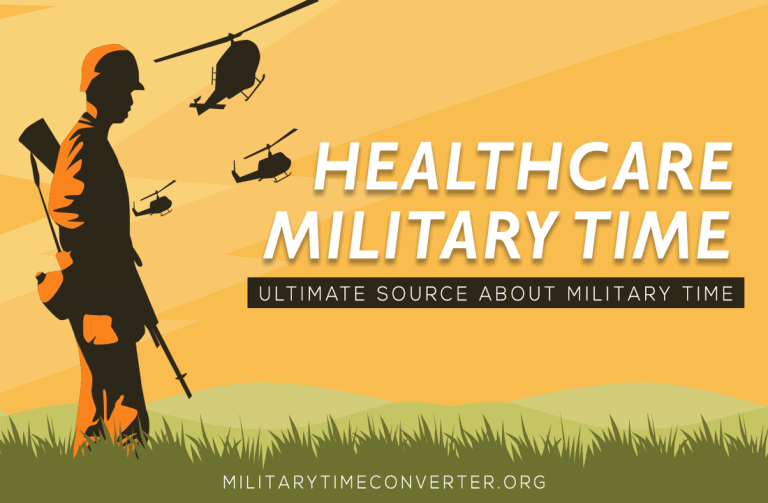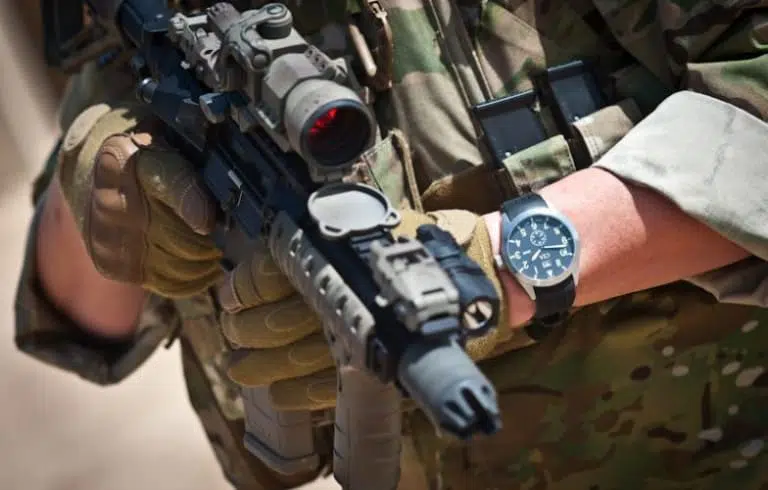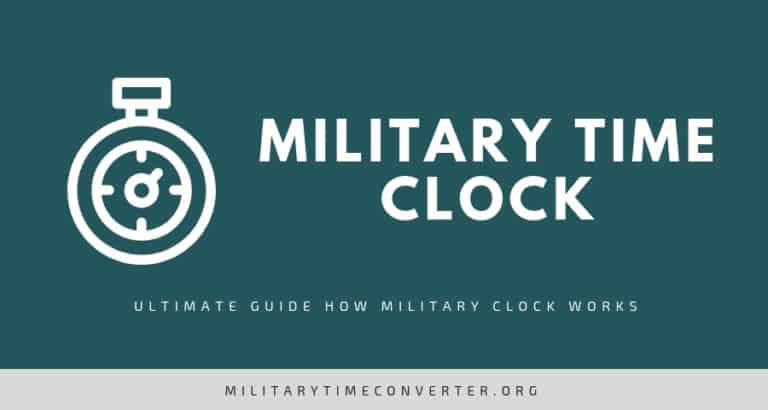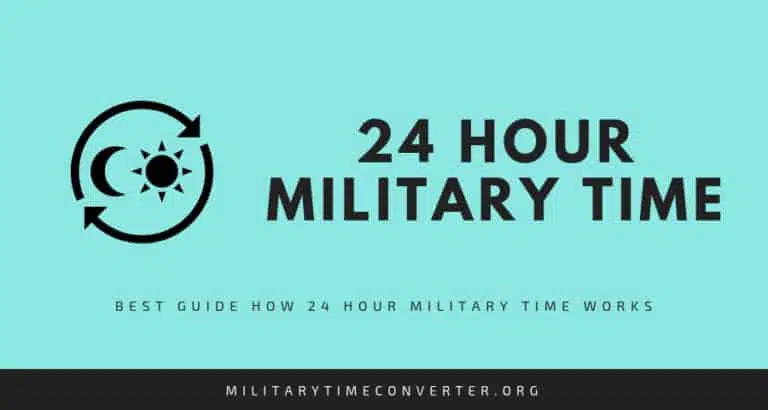Military Time Guide: Simple Explanation with Examples
Important Note: When you buy through our links, we may earn a commission. As an Amazon Associate we earn from qualifying purchases. Content, pricing, offers and availability are subject to change at any time - more info.
Even if you’re not in the military, you’ve probably heard of Military Time; you might’ve had a friend or coworker who talked about time with hours that are higher than 12. Military Time can sound strange if you’re not sure what it is. So, what is Military Time?
Military Time is a time format that counts the hours in a day from 0000 to 2400, which leaves out AM and PM. This way of telling time is more specific and typically results in less confusion than other time formats.
While the name makes you think it’s a time format only used by the military, Military Time actually has a long history and has been used by people who aren’t in the military.
How does Military Time Work? More Than Just the Military
Military Time is used by both people in the military and civilians for a few obvious reasons. The 24-hour time format leaves little confusion compared to the 12-hour time format, commonly called Normal or Standard, to use.
Have you ever set your clock to 7 PM instead of 7 AM when you had to wake up for work? Most people have done something similar, whether it was for work, school, or even just a get-together. It’s frustrating to say the least, and it’s a bad way to start the day.
If you use a 24-hour time format, like Military Time, then you don’t have to worry about this issue. In high-stakes situations, such as military orders and meetings, it’s extremely important that there is zero confusion. That’s why the military uses it, and why it so lovingly has the name ‘Military Time.’
Using military time is easy; if you’re really feeling dedicated, you can even change the clock on your smartphone to show in military time! This will really help if you’re someone who tends to miss meetings because of wrongly-set alarm clocks.

You can download this infographic in a printable version.
For more information on the differences between Military Time and Normal/Standard Time, check out this article!
If you’re trying to convert Military Time to Standard/Normal Time, good news: it’s easy! We have an easy formula that you can follow. Before you start the steps, there are two main rules for converting time:
- For the time from 0000 to 1159 Military Time, we use AM in Standard Time and for the time from 1200 to 2359, we use PM in Standard Time.
- For the time from 0000 to 1259 Military Time, we don’t subtract any numbers but for the time from 1300 to 2359, we always have to subtract 12.
Now that you know that, let’s jump into the steps on how to convert military time!
- Determine if the time is greater than 1300 or not.
- If it’s greater than 1300, then subtract 1200 from the time. If it’s smaller than 1300, skip this step.
- Add the colon between the hours and minutes (the first two numbers and the last two numbers).
- Insert AM for the time smaller than 1200 or PM for the time greater than 1200
- Voila! You’ve done it.
Those rules might sound a little complicated on paper, but they’re easy to implement in practice. In case it’s all a little confusing, here are two examples using an AM and PM time conversion.
Converting 1800 Military Time to Standard/Normal Time:
- Is 1800 greater than 1200? – Yes, so it’s PM
- Then 1800 – 1200 = 600
- Add the colon between hours and minutes and it would be 6:00
- Insert PM (from Step 1)
- The conversion of 1800 Military Time is 6:00 PM Standard Time
Converting 0900 Military Time to Standard/Normal Time
- Is 0900 greater than 1200? – No, so it’s AM
- It’s AM, so you can skip this step
- Add the colon between hours and minutes and it would be 9:00
- Insert AM (from Step 1)
- The conversion of 0900 Military Time is 9:00 AM Standard Time
These examples use exact hours, but it’s super simple if it’s not on the hour. Think about it: none of the numbers change from Military Time and Normal/Standard Time when it comes to the minutes, so you don’t really have to change anything or pay attention to them.
If you want to better understand how you can make the conversion from Military Time to Normal/Standard Time, you can check out this post on Specific Military Time Conversions.
Military Time Chart
Converting Military Time can be difficult; that’s why we’ve created a Military Time Chart to give you an easy cheat sheet when you’re trying to convert times. Using this will make sure you’re converting everything correctly, so it’s a great tool if you’re just starting to use Military Time.
You can find a complete, printable Military Time Chart with an explanation on how to use it in this article.
Military Time Clocks
Did you know that you can get a clock that shows Military Time? If you’re trying to get used to using Military Time, then try checking these out! They’re helpful, and many people find that they like them better because of their simplicity (once you learn how to read it well).
Because Military Time is a 24-hour time format, Military Time clocks actually have 24 hours on it instead of 12. This can definitely throw you off at first, so be prepared to double-check your times when you first get one.
You can read more about how a Military Time clock works in this article I wrote.
How to Read Military Time Like a Pro
While the time formats might look similar, Military Time and Normal/Standard Time are read differently.
Military Time always contains four numbers: the first two denote the hour while the last two denote the minutes. When you’re reading this out, you’ll typically be saying each number group. However, the hours tend to get messy.
If you’re talking about an exact time on the hour, such as 0700, or 7:00 AM, then you’d say Zero Seven Hundred hours. Since there are no minutes, you’d end the time with ‘hundred.’
Note that there is a zero before seven; this is to represent the zero before the seven; if it was 1100, you wouldn’t need to say zero.
Here are a few quick examples:
| Military Time | Pronunciation |
|---|---|
| 0400 | Zero Four Hundred hours |
| 0735 | Zero Seven Thirty-Five hours |
| 0904 | Zero Nine Zero Four hours |
| 1300 | Thirteen Hundred hours |
| 1730 | Seventeen Thirty hours |
| 2305 | Twenty-three Zero Five hours |
If you’d like a more in-depth guide on how to read military time, then check out this guide.
Military Time and the Military Alphabet: How They Go Together
If you’re a fan of military or history movies, then you’ve probably heard the phonetic alphabet without even realizing it! The most common codes, Alfa, Bravo, Charlie, Delta, and Zulu, are common code names. Even popular video games are using the codes, especially first-person shooting games.
The military uses a phonetic alphabet, also known as the NATO phonetic alphabet or military alphabet, in all of its operations. Military Time can actually include this alphabet in the case that a communication will go over time zones.
The phonetic alphabet is combined with the UTC codes that time zones have to create a reliable way to communicate times. This is where things can get confusing, but it’s extremely important when troops are being mobilized and undergoing operations at specific times. Each UTC code also has a major city with it, so you can see where your time zone lies along with places that you’re close to.
Here are a few examples to help you understand what I mean by this:
| Zone | Time Offset | Major City |
|---|---|---|
| Alpha | UTC+1 | Paris, France |
| Bravo | UTC+2 | Munich, Germany |
| Charlie | UTC+3 | Moscow, Russia |
The Earth is divided into 24 major time zones, each of which has its own UTC time offset. That means that the first 24 letters of the phonetic alphabet are used! If you’d like to see the entire phonetic alphabet and how it works with Military Time, check out this post.
The most interesting time zone is the Zulu Time Zone, or Greenwich Mean Time (GMT). This is the time zone that most of the world uses, and it starts at noon. However, UTC codes were created to offset GMT as it counts from midnight instead of noon. Military Time is based on UTC.
This is a pretty confusing concept, so here’s an example to help you understand more:
If someone tells you that the plane is departing at 1200 Zulu Time, and you’re in Munich, Germany, then you know you’re in UTC+2. In order to convert to Military Time or Normal/Standard Time, you’ll need to add 2 hours to 1200, so the departure time is actually 1400 Bravo Time (based on the UTC code), or 2:00 PM Normal/Standard Time.
If you’d like to learn a little more about Time Zones and how they all connect, you can check out this guide
The History Behind Military Time
Military Time actually goes back thousands of years, and it’s only fairly recently (on a world timeline) that it’s been called Military Time. Understanding the history of Military Time can actually help you understand the format better.
Military Time, or a 24-hour time format, actually started back in the Egyptian era, the astronomical system of decans to be exact. Since then, astronomers, scientists, navigators, and now militaries have used it.
Mechanical clocks saw Military Time early in clock history in Italy. The first 24-hour clock had different signs for all 24 hours, and there was an hour and minute needle. That means the clock could strike up to 84 times just to tell one specific time!
In 1884, Lewis M. Rutherford actually suggested that people use Military Time in day-to-day life. His thought process was that people would better unders how Earth rotates and communications would never be confused.
World War I saw Military Time being used in every participating country as world leaders started realizing how essential communication was. Because of the number of civilians who were drafted in the war, most civilians became aware of Military Time. It was so accurate that even after the war ended people chose to use it, especially throughout Europe. Today, most of Europe uses Military Time in day-to-day life.
Some countries that weren’t involved (or that didn’t have fighting on it’s shores, like the United States) still use Normal/Standard format. Perhaps time will lead to these countries making the switch.
To learn more about the history of Military Time, you can visit this post.
Online Tools/Resources
I’ve created these free tools for you to use to easily convert times between Military and Normal/Standard. By the way, you can share these with your friends or family if you want your social circle to convert to Military Time!
Converter from Military Time to Normal/Standard Time
| Standard Time: |
Converter from Normal/Standard Time to Military Time
| Military Time: |
Current Time Converter Based on Your Current Time and Location (Don’t worry—your location information is safe with us.)
For help on how to use the first two converters, check out this article. For more information and guidance on the second converter, take a look at this post.
FAQ About Military Time
Still didn’t see what you were looking for? These frequently asked questions can provide you with any additional information.
What is 0000 or 2400 hours?
Midnight, or 12 AM, can be called both 0000 nad 2400 hours; typically, you’ll hear 0000. Military Time clocks will always display 0000, and you won’t see 2400 on the clock. And yes, if you use 0000, you pronounce both zeros before you say hundred hours.
Why is Military Time called Military Time?
24-hour time format started to be widely used during World War 1 when all armies started using this format. That’s why the nickname for the 24-hour format is Military Time.
What is the difference between Military and Normal/Standard Time?
There are two differences between Military time and 24-hour time. Military Time uses a leading zero and doesn’t use a colon. On the other hand, Normal/Standard Time doesn’t use leading zero and uses a colon.
Military Time also, in most cases, has a letter after it to denote the zone. You won’t see this with Normal/Standard Time. Instead, you’ll see time zones, such as EST or PST.
Military Time also has a universat time, the Zulu or zone Z. Normal/Standard time doesn’t have anything that is the same thing, so you’ll always be changing times if you’re located in another time zone.
Military Time also pronounces a leading zero if one exists. However, Normal/Standard Time doesn’t ever pronounce a leading zero, and one is never written either.
How do I convert Military Time?
When you see the time greater than 1300 Hours, subtract 12 hours and add PM after calculated time. On the other hand, for a time smaller than 1300 hours, add AM after a given time.
Why does the military use 24-hour time?
The military uses Military Time because no army can risk the confusion of AM and PM. There is no space to make mistakes in the military. Mistakes may cause the death of innocent people or our soldiers.
Where do people use Military Time?
Military Time is used in almost all countries of the world people on a daily basis. On the other hand, the 12-hour time format is used in the United States, Philippines, Canada, Australia, New Zealand, India, Egypt, Saudi Arabia, Columbia, Pakistan, and Malaysia.
Do Americans use Military Time?
No, Americans don’t normally use 24-hour time format, they use 12-hour time format. But the US military, pilots or emergency services use 24-hour time format in their jobs.
What is 12 AM in 24-hour time?
12 AM can be written as 0000 or 2400 hours in a 24-hour time format, and it means midnight. It is read as ‘twenty-four hundred hours’ (2400 hours) or ‘zero zero hundred hours’ (0000 hours).
Conclusion
For most of the world, Military Time, or a 24-hour time format, is an important aspect of life. You’ll more than likely find yourself, at some point in your life, needing to convert to or from Military Time if you live in the United States. It’s very similar to the metric system and imperial system debate
You might even find that you like Military Time better than Normal/Standard Time; that’s great! You can easily make the switch and stop missing appointments or meetings because of failed alarms. If you’re someone who travels, then you’ll definitely need to adjust if you ever go to Europe!
I hope this article helps you understand what Military Time is, how you can convert it, and any other questions you might have.
If you are still interested and would like to learn more about Military Time, then check out the other posts located in various categories from the main menu.
Also, share this post with your friends and family! Who knows; you could switch your social circles over to using Military Time. That’s how change happens!






